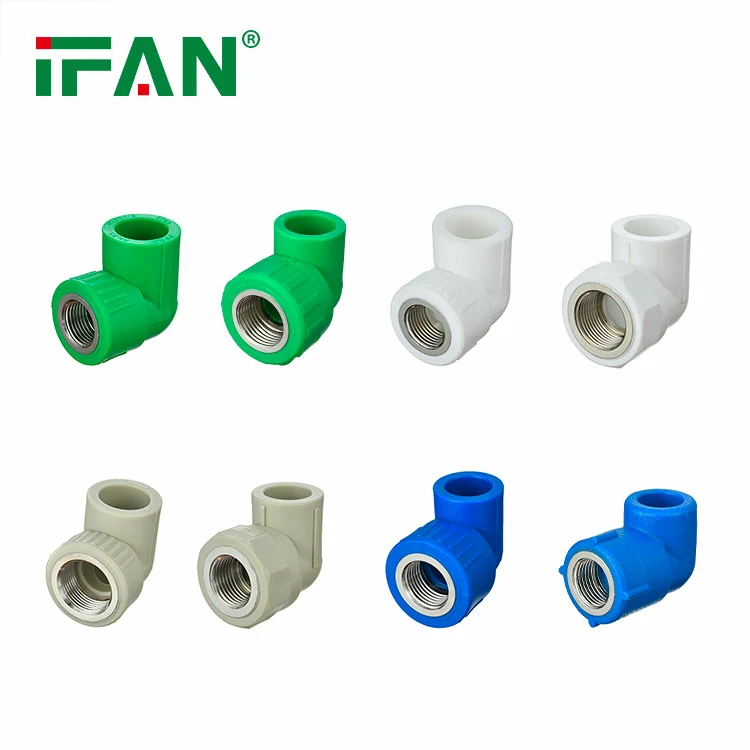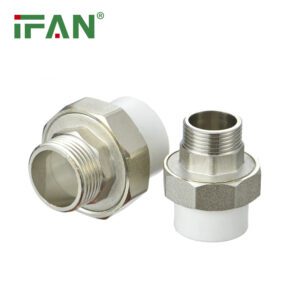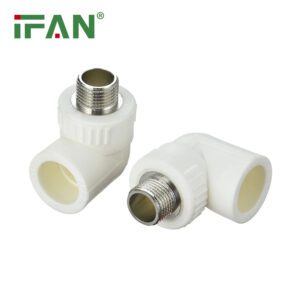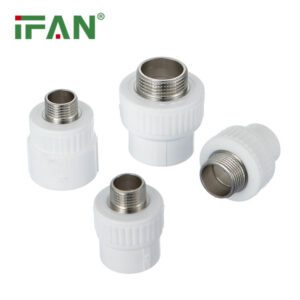IFAN factory 30+ years manufacture experience support color /size customization support free sample.Welcome to consult for catalog and free samples.This is our Facebook Website:www.facebook.com,Click to watch IFAN’s product video.Compared with Tomex products, our IFAN products from quality to price are your best choice, welcome to buy!
Introduction
Polypropylene Random Copolymer (PPR) fittings have become a popular choice in modern plumbing systems due to their durability, resistance to corrosion, and cost-effectiveness. Whether for hot or cold water systems, PPR fittings offer an efficient solution for both residential and commercial applications. One of the key methods of joining PPR pipes and fittings is through welding, a process that creates strong, leak-proof connections. In this article, we will dive into everything you need to know about PPR welding and joining techniques, with a focus on PPR fittings, their types, and installation best practices.
What are PPR Fittings?
PPR fittings are specialized components made from PPR (Polypropylene Random Copolymer) material used to connect and direct the flow of water through a piping system. These fittings include elbows, tees, reducers, couplings, and valves. PPR fittings come in various sizes to match PPR pipes, which are typically used in plumbing, heating, and other fluid conveyance applications.
One of the most significant advantages of PPR fittings is their ability to withstand high temperatures and pressures. This makes them suitable for both residential plumbing and industrial applications.
PPR Welding: A Reliable Method for Joining PPR Fittings
The most common method for joining PPR pipes and fittings is welding, specifically **butt fusion welding** and **electrofusion welding**. These techniques ensure that the connections are secure, leak-free, and durable. Let’s take a closer look at each of these techniques.
1. Butt Fusion Welding
Butt fusion welding is the most widely used method for joining PPR fittings. This technique involves the following steps:
1. Preparation of the PPR Pipe and Fitting: Both the ends of the PPR pipe and fitting are cleaned and heated.
2. Heating: A heating element is placed between the ends of the pipe and fitting. This melts the material at the joint.
3. Joining: The heated pipe and fitting are pressed together under controlled pressure, causing the material to fuse.
4. Cooling: After joining, the fusion site is allowed to cool and solidify, creating a strong bond between the pipe and fitting.
Butt fusion welding provides a strong, permanent connection, and is preferred in situations where the piping system must withstand high pressures and temperatures.
2. Electrofusion Welding
Electrofusion welding is another popular method for joining PPR pipes and fittings. This method uses special fittings that have built-in electrical heating coils. Here’s how the process works:
1. Preparing the Pipe and Fitting: The pipe and fitting are cleaned to ensure good contact during welding.
2. Fitting Installation: The electrofusion fitting is placed around the pipe, and electrical connections are made to the heating coils.
3. Heating and Fusing: The electrical current heats the coils inside the fitting, melting the pipe and fitting material. This creates a strong, leak-proof bond between the two components.
4. Cooling: Once the joint has fused, the fitting is allowed to cool and solidify.
Electrofusion welding offers more flexibility than butt fusion, especially in tight spaces or areas with limited access. It also requires less heavy equipment, making it a convenient option for smaller installations or repairs.
3. Socket Fusion Welding
Socket fusion welding is another technique where a pipe is heated and inserted into the socket of a fitting. The process involves:
1. Heating: The pipe end and the fitting socket are heated using a socket fusion tool.
2. Insertion: The heated pipe is inserted into the fitting, creating a strong bond as both parts cool and solidify.
This technique is particularly suitable for smaller PPR pipe diameters and is a great choice for domestic plumbing systems.
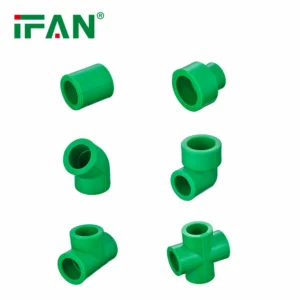
Key Benefits of PPR Fittings and Welding Techniques
Using PPR fittings and welding techniques offers several significant benefits:
1. Durability and Strength: PPR fittings create highly durable, leak-proof joints that last for many years, even under harsh conditions.
2. Corrosion Resistance: PPR material is highly resistant to corrosion, unlike traditional metal pipes, making it ideal for water systems.
3. Temperature Resistance: PPR fittings can handle both hot and cold water without risk of degradation, making them suitable for a wide range of applications.
4. Ease of Installation: Compared to other piping systems, PPR welding methods like butt fusion and electrofusion are relatively easy to learn and implement.
5. Cost-Effective: PPR fittings and the welding processes are affordable compared to traditional metal pipe fittings, which helps reduce overall project costs.
How to Install PPR Fittings Using Welding Techniques
To ensure a successful installation of PPR fittings, follow these steps:
Step 1: Select the Right Tools and Equipment
Make sure you have the appropriate welding tools for the specific technique you are using. For butt fusion welding, you will need a fusion machine, heating elements, and clamps. For electrofusion welding, you’ll need electrofusion fittings and a power source.
Step 2: Measure and Cut the Pipe
Carefully measure the length of the PPR pipe that needs to be cut, and use a pipe cutter to make a clean, straight cut. This ensures the proper fit of the pipe into the fitting.
Step 3: Prepare the Pipe and Fitting
Clean the ends of the pipe and the inside of the fitting to remove any debris or contaminants. This ensures the weld is secure and free from defects.
Step 4: Perform the Welding Process
Use the chosen welding technique (butt fusion, electrofusion, or socket fusion) to join the PPR pipe and fitting. Be sure to follow the manufacturer’s guidelines regarding temperature and pressure settings.
Step 5: Allow for Cooling and Inspection
After welding, allow the joint to cool and solidify before inspecting the connection for any issues. Make sure the joint is firm and leak-free.
Troubleshooting Common PPR Welding Issues
While PPR welding is generally straightforward, some common issues may arise:
— Poor Joint Quality: Ensure that the pipe and fitting are properly aligned during the welding process to avoid weak joints.
— Overheating or Underheating: Too much heat can damage the material, while insufficient heat can result in weak joints. Always follow the correct temperature settings.
— Contaminated Surfaces: Dirt or moisture on the surfaces of the pipe or fitting can cause weak welds. Always clean the components thoroughly before welding.
Conclusion
PPR fittings and welding techniques are an excellent choice for plumbing systems that require durability, flexibility, and long-term performance. By understanding the different welding methods—such as butt fusion, electrofusion, and socket fusion—you can select the best approach for your installation needs. PPR systems are cost-effective, easy to install, and offer strong, leak-proof connections that will last for years.
FAQs
1. What are the main types of PPR welding?
The three main types of PPR welding are butt fusion welding, electrofusion welding, and socket fusion welding. Each method has its advantages depending on the application.
2. Can PPR fittings be used for both hot and cold water systems?
Yes, PPR fittings are designed to handle both hot and cold water systems due to their high-temperature resistance and durability.
3. How long do PPR fittings last?
PPR fittings can last for over 50 years, depending on factors like usage, environmental conditions, and maintenance.
4. Can I use PPR fittings for industrial applications?
Yes, PPR fittings are suitable for industrial applications, especially in systems that require corrosion resistance and high-temperature handling.
5. Do I need specialized training to install PPR fittings?
While basic installation requires some experience, most people can learn to install PPR fittings with proper training and the right tools. However, it is recommended to consult a professional for large-scale installations.
Похожие товары
- PPR Fittings Полипропиленовые Фитинги
Муфта комбинированная разъемная американка НР ППР
- PPR Fittings Полипропиленовые Фитинги
Муфта ППР комбинированная разъемная американка ВР
- PPR Fittings Полипропиленовые Фитинги
Угольник 90° комбинированный НР ППР
- PPR Fittings Полипропиленовые Фитинги
ППР Муфта комбинированная НР
